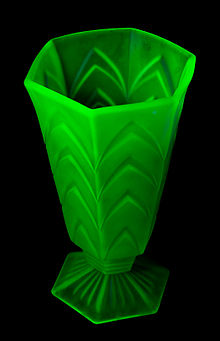A piece of yellow glass made around 79 AD colored with uranium from found near Naples, Italy is the first known use of uranium. The uranium mineral called pitchblende or uraninite was noticed and reported as long ago as 1565 in mines in Saxony in northwest Germany. Uranium was first recovered in 1789 from analysis of mineral samples from the Joachimsal silver mine in the Czech Republic by a German chemist named Martin Heinrich Klaproth. Klaproth named this new mineral for the planet Uranus. Within the next 15 years, uranium was found in England, France, Austria and Romania but in ores much poorer that in the mines of Joachimsal.
During the 1800s, uranium ore was extracted as a byproduct of mining in Saxony, Bohemia and Cornwall. Oxides of uranium were used for fabrication of steel alloys, chemical experiments and as a pigment to add color to dyes, inks, glass and ceramics. Vases and glassware were given a yellow-green color and crockery was colored from orange to bright red with the addition of uranium.
Pure metallic uranium was first prepared by the French chemist Eugene Peligot in 1841. In 1870, Russian Chemist Dimitri Mendeleyev used his periodic table classification system to show that uranium was the heaviest and highest atomic weight element naturally present on Earth. By 1900, over 1000 scientific papers had been published on the chemical and health effects of uranium.
In 1896, French chemist Henri Becquerel discovered natural radioactivity when he noticed that uranium salts left near photographic plates fogged the plates. Marie and Pierre Curie followed up on Becquerel’s research and discovered a new element in 1898 they named radium. Ernest Rutherford from New Zealand and English chemist Frederick Soddy proposed a theory of radioactive transformation. Radium was understood to have been created by the transmutation of uranium. Eventually it was found that naturally occurring uranium was weakly radioactive and that through a process of decay, a series of elements was created with the final element being non-radioactive lead.
During the early Twentieth century, uranium was overshadowed by its daughter element, radium. Increasing demand for radium used in creating fluorescence displays and tumor treatments increased the demand for uranium and uranium mining expanded. Prior to World War II, most of the uranium mined in the United States came from mixed ores of vanadium and uranium.
In the 1930, Leo Szilard conceived of a chain reaction which he believed could be fueled by uranium. A few years after his discovery, he contacted Albert Einstein because he feared that Germany might be able to use uranium to create weapons. They sent a letter to U.S. President Franklin Roosevelt and begged him to seriously consider this possibility.
In 1939, Otto Hahn in Germany created the first confirmed example of nuclear fission. As the world drifted towards war, the United States started the top secret Manhattan Project to develop a bomb based on chain reactions of uranium. Enrico Fermi led a team to create the first nuclear reactor at the University of Chicago. In 1942, Fermi and his team achieved the first controlled nuclear reaction.
Picture of a Depression Era glass vase colored with uranium taken by JJ Harrison (jjharrison89@facebook.com):
